

Subscribe via Itunes [1] | Subscribe via RSS [1]
What's inside your computer?
The computer is an enigma to a lot of people. You press some keys, and you somehow the screen, printer, or speakers start working. But what is inside the computer--and how does it all work together?
In this general education tech tip, we'll teach you about the parts that make your computer work. Don't worry--you won't have to brush up on all those engineering and calculus classes you took back in college to understand it. ;p
The core of the computer has a few basic components. Those are...
With these minimal components you can power on a computer. It won't do much, but you can power it on.
From there, we add other devices that expand functionality of the computer. Common components include
Hard Drive [3]
Sound Card [4]
The above is not an extensive list of things that can be in a computer, but they are the most common parts in nearly every computer. For the sake of brevity and efficientcy, we'll limit it to these items.
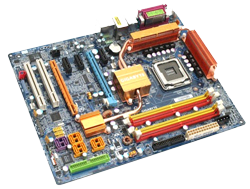 We'll start with this guy, and for good reason. The motherboard (sometimes called a mainboard for the politically correct), is what ties everything together. It's the huge circuit board that everything connects to and routes information to where it needs to go. For example, when you play a song on your computer, here's what happening with the motherboard:
We'll start with this guy, and for good reason. The motherboard (sometimes called a mainboard for the politically correct), is what ties everything together. It's the huge circuit board that everything connects to and routes information to where it needs to go. For example, when you play a song on your computer, here's what happening with the motherboard:
- You use your mouse or keyboard to a request to load a file from the hard drive.
- It gets routed into RAM (memory) and from there to the processor.
- The processor then sends the information from that music file to your sound card.
- Lastly, your sound card is hooked up to your speakers, and thus: Ta da!!! You hear the sound of your favorite song.
See, it's not all that difficult is it?
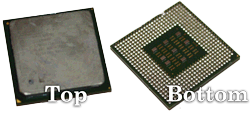 The CPU is nothing but amazing. This is the heart of modern computing technology. Of course many other things play a significant role; but the CPU is chief among them. The CPU is what does most of the “thinking” or processing in computers. Modern computers usually come with multiple CPU's to share the work. Some computers come with as many as 8 “cores”.
The CPU is nothing but amazing. This is the heart of modern computing technology. Of course many other things play a significant role; but the CPU is chief among them. The CPU is what does most of the “thinking” or processing in computers. Modern computers usually come with multiple CPU's to share the work. Some computers come with as many as 8 “cores”.
AMD and Intel are two of the most known CPU manufacturers out there, but there are many more such as IBM, Motorola and nVidia.
A major focus in CPU's today is the mobile CPU market for smartphones and tablets.
Want more details on the CPU? Check out our CPU Tech Tip [8]!
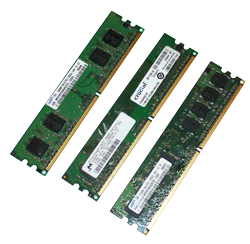 This guy is largely responsible for the speed of your computer. Don't however confuse this with hard drive storage. RAM is “temporary memory.” It does not store things once the computer is turned off. It generally only stores things that are open and running.
This guy is largely responsible for the speed of your computer. Don't however confuse this with hard drive storage. RAM is “temporary memory.” It does not store things once the computer is turned off. It generally only stores things that are open and running.
RAM (Measured in MB or GB). Whenever you open a program, visit a webpage or do just about anything in the computer, it gets loaded into RAM. The reason ram exists is because it is significantly faster than the hard drive. Depending on what you are doing it can be as much as 100,000 times faster.
So when you load a program, your Hard Drive (HD) light flashes for a while, and what it is doing is loading the program into memory (RAM). Once the program is in RAM, when you click or do things with that program, your program it responds quickly. This is because it now resides in RAM. If your programs and certain files didn't get stored temporarily in your RAM while you are using your computer, it would have to get everything from the hard drive, which takes a long time by today's standards.
Often when a computer is slow, it's because it doesn't have enough RAM to meet all the demands. What happens in this case is the computer starts using “virtual memory” or the “page file”. It starts using the Hard Drive as “virtual RAM”, so the computer doesn't crash due to memory issues; but it does run significantly slower.
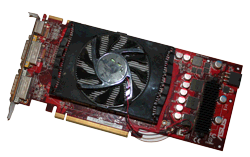 The video card is what you plug your monitor into. It's responsible for generating the images you see on your screen. In many computers and laptops these devices are “integrated” into the motherboard. That means it's actually a part of the motherboard, instead of being a separate device. In the older days of computing, nearly everything was an add-on component. However modern computers have nearly all components integrated to the motherboard except a few items.
The video card is what you plug your monitor into. It's responsible for generating the images you see on your screen. In many computers and laptops these devices are “integrated” into the motherboard. That means it's actually a part of the motherboard, instead of being a separate device. In the older days of computing, nearly everything was an add-on component. However modern computers have nearly all components integrated to the motherboard except a few items.
Graphics cards can be as simple or “super-charged” as you'd like. In fact some graphics cards cost more than an entire computer! These devices are pretty impressive. They contain their own processors (GPU – Graphical processing units) and memory. They can be essentially full computers in and of themselves.
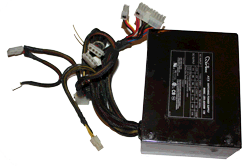 Well this should be easy enough. This is the guy that provides power to all the parts in the computer.
Well this should be easy enough. This is the guy that provides power to all the parts in the computer.
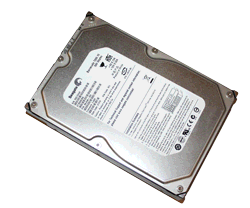 The hard drive is NOT the case/tower. This is one of the most misused terms when talking with clients. The hard drive is actually a component inside the computer.
The hard drive is NOT the case/tower. This is one of the most misused terms when talking with clients. The hard drive is actually a component inside the computer.
The hard drive is used to permanently store the information in the computer. When you “save a file," you are writing it to the hard drive. All your “My Documents” or Itunes files are stored on the hard drive.
Hard drives differ from memory in that they can store information even when the computer has no power. However they are significantly slower than RAM. This is why we used hard drives to store information, then load it into RAM when we want to use that information. Your windows, programs and everything you have in your computer is stored on the hard drive.
A new modern style of hard drive is growing in popularity, the Solid State Drive (SSD) [9]. This is a hard drive with no moving parts that is as much as 10 times faster than traditional hard drives. They're pretty impressive! I use one in my personal computer and our PcComputerGuy.com website runs off this style of hard drive. They are quite a bit more expensive than traditional (mechanical/magnetic) hard drives.
These things can and will fail. And when they do you've lost all your information... unless you've followed our advice and backed up your system. Parts are replaceable. Your information isn't.
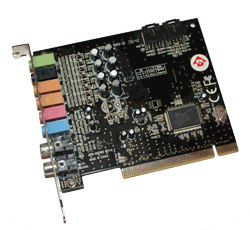 The sound card is what produces all the audio you hear. Most of the time this is now integrated into the motherboard, but not always. Without the sound card you hear nothing.
The sound card is what produces all the audio you hear. Most of the time this is now integrated into the motherboard, but not always. Without the sound card you hear nothing.
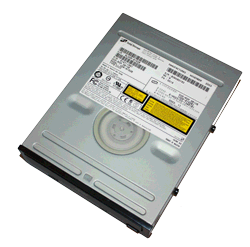 This one should be pretty obvious. You use it to load programs or transfer information (i.e. burning files/music). Believe it or not, these guys are actually disappearing. In the coming years, fewer and fewer computers will have CDROM's in them. Instead you'll be expected to get the files from the Internet or flash drives.
This one should be pretty obvious. You use it to load programs or transfer information (i.e. burning files/music). Believe it or not, these guys are actually disappearing. In the coming years, fewer and fewer computers will have CDROM's in them. Instead you'll be expected to get the files from the Internet or flash drives.
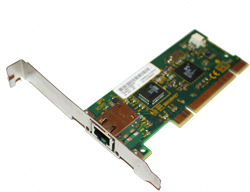 The Internet and our “modern era” wouldn't exist without this wonderful device! It, like the sound card, is nearly always integrated into the motherboard. This component is what is responsible for sending and receiving information to and from your computer. When you pull up a website, you can thank the network card for getting that information for you. When you are watching Netflix – again it's the network card getting that information from Netflix. Basically any communication outside of your computer is done with this device. If it weren't for your network card, you wouldn't be reading this article!
The Internet and our “modern era” wouldn't exist without this wonderful device! It, like the sound card, is nearly always integrated into the motherboard. This component is what is responsible for sending and receiving information to and from your computer. When you pull up a website, you can thank the network card for getting that information for you. When you are watching Netflix – again it's the network card getting that information from Netflix. Basically any communication outside of your computer is done with this device. If it weren't for your network card, you wouldn't be reading this article!
The last piece of the puzzle is the Operating System. This is what ties all the components together in terms of software. The motherboard physically connects everything together, but the OS is the conductor telling whom to do what. This is your Windows XP or Windows 8, Mac OS or Linux variants.
So there you have it. You now have a break down of the key components inside of every computer and hopefully have a birds-eye-view understanding of how they work together to make this magical box work. That wasn't so bad was it?
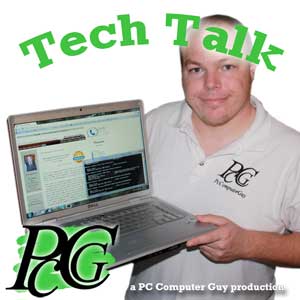
Links
[1] http://pccomputerguy.com/podcast/feed.xml
[2] https://www.pccomputerguy.com/Tech-Tips-Podcast-Parts-of-a-Computer/page/0/1%23PowerSupply
[3] https://www.pccomputerguy.com/Tech-Tips-Podcast-Parts-of-a-Computer/page/0/1%23HardDrive
[4] https://www.pccomputerguy.com/Tech-Tips-Podcast-Parts-of-a-Computer/page/0/1%23Sound
[5] https://www.pccomputerguy.com/Tech-Tips-Podcast-Parts-of-a-Computer/page/0/1%23CDROM
[6] https://www.pccomputerguy.com/Tech-Tips-Podcast-Parts-of-a-Computer/page/0/1%23Network
[7] https://www.pccomputerguy.com/Tech-Tips-Podcast-Parts-of-a-Computer/page/0/1%23OS
[8] https://www.pccomputerguy.com/Tech-Tips-Podcast-CPU-Central-Processing-Unit
[9] https://www.pccomputerguy.com/Tech-Tips-Podcast-Solid-State-Drive-SSD
[10] https://www.pccomputerguy.com/Tagged-Items-Under-Tech-Tips
[11] https://www.pccomputerguy.com/Tagged-Items-Under-Tech-Tips-Articles
[12] https://www.pccomputerguy.com/Tagged-Items-Under-Tech-Tips-Podcasts
[13] https://www.pccomputerguy.com/Tagged-Items-Under-Tech-Tips-Videos